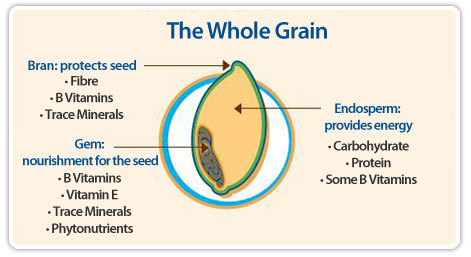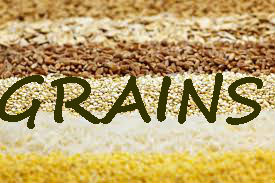Trying to eat healthy can be overwhelming with all the health claims and diet trends in the media, especially in January when many of us are trying to eat healthier. In Part 1 of our ” healthy eating series” we are gong to talk about grains, what they are, and how to make better choices. How many of us really know what a “grain” is? Before cutting grains out completely lets take a closer look at their make up and perhaps give other grains to try.

What is a whole grain?
Whole grains are made of three parts:.
Germ- Contains vitamins, minerals, and essential fats
Bran- Contains the fiber and protein
Endosperm- mainly starch, lacks fibre, vitamins, and minerals.
Examples of whole grains include quinoa, oats, spelt, rye, wheat berries, millet, amaranth, buckwheat, brown and purple rice, kamut, and corn.
What are refined grains?
Refined have only the endosperm which provides energy, carbohydrates, some protein, and a little B vitamins. To improve their nutritional value food manufactures are required to fortify refined grains with the lost nutrients i.e. vitamins, minerals, and iron. It’s very difficult to take something out of food and put it back in its natural form. Refined grains include anything white- white flour, wheat ( not 100%), wheat flour ( not 100 %), all white rice ( basmati, arborio, shortgrain, longrain) , enriched flour, semolina, oat bran, and refined oat flour. Remember , refined grains only contain the endosperm.
How do I know if I am consuming a “wholegrain” ?
In order for a grain to be 100% whole grain it must contain the word “whole.” F or example,whole-grain whole wheat, whole durum wheat, wholegrain corn, wholegrain cornmeal. In Canada, whole wheat flour contains at least 95% of the original kernel. According to the food and drug regulations up to 5 % of the kernel can be removed to decrease rancidity. On the other hand, whole wheat whole grain has 100 % of the kernel intact.
How about whole wheat , multigrain breads, how do I make the right choice?
I will be honest bread is a hard thing to buy when it comes to making a healthy choice. Most major bread companies, I will refrain from naming them, place claims on their packages to make them seem ” healthy”, I have been fooled too. Most breads are a mixture of both whole grains and refined grains, usually 20 % wholegrain and 80 % refined and may contain up to 40 unwanted ingredients including sugar, artificial flavours and dyes, yikes. The ONLY way to determine if a bread is healthy is look at the ingredient list. I encourage you to look at the ingredient list of your bread right now and don’t rely on the health claims on the package.
A healthier bread should contain no more than 5-6 ingredients, you should recognize them. Look for sprouted grains, high fibre, and ones low in sugar. The best place to buy bread is your local bakery, ask questions about their ingredients and how it is made. It may cost an extra dollar but you will be getting a good quality bread that tastes better and is better for you.
What about multi-grain?
Whenever you see the word multi means more than one grain. This does not necessarily mean its “whole” as it may contain both refined and unrefined grains. Read the ingredient list and you should see the word “whole” only.
What about gluten-free products ?
Celiac disease is an autoimmune disease that causes damage to the lining of the small intestines absorption area when gluten is eaten. Gluten, a protein, is found in many grains including wheat, spelt, farro, durum, semolina, bulgur, triticale and rye. People who have celiac disease may experience digestive symptoms such as abdominal bloating, gas, pain and fatigue. Like some multi-grain products some gluten free products are highly processed, and the claim “gluten-free” should not be mistaken for healthy, you still have to read the ingredient list. Healthy gluten free grains include gluten free oats, quinoa, brown rice, and sorghum.
What about sprouted grains?
Sprouted grain undergo a process of germinating , process in which plants grow from a seed. The process of germination improves nutrient bioavailability, increased antioxidants and enzymes, increase soluble fibre, and omega 3 fatty acids. Good examples of sprouted grains found in supermarkets are Silver Hills Bread, sprouted corn tortillas, and Ezekeil sprouted grains.
Bottom line always reading the ingredient list first, it will tell you about the quality of the ingredients. Choose products that are made of “whole” grains and contain no more than 5-6 ingredients.
My Opinion:
Please remember this blog is about my thoughts and opinions and they will not align with everyone. If you have celiac disease you must always avoid gluten. If you are like myself and don’t get any symptoms like abdominal bloating and gas when you eat wheat , then go ahead and enjoy whole grain whole wheat products within moderation. Most of us consume too much wheat in its overly processed state, which may leave many of us feeling fatigue, bloated and gassy. Try eating grains in their whole intact form like quinoa, steel cut oats, wheat berries. Lastly, eat more FRESH and SEASONAL vegetables and fruit and see if you notice a difference.
Sources: Health Canada

